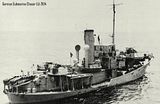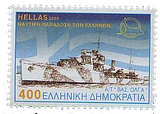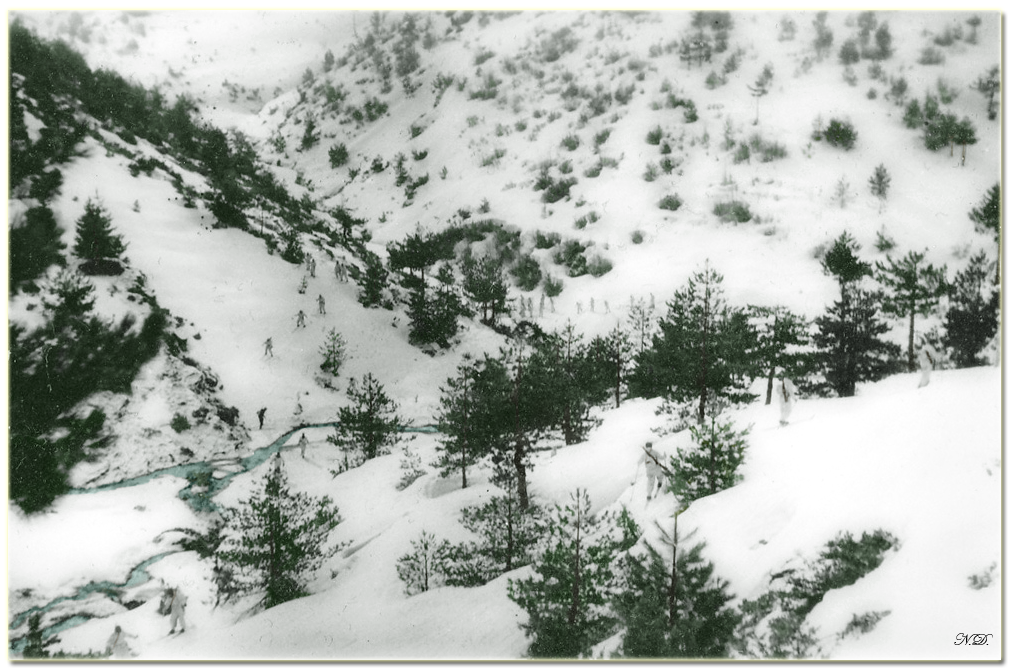 In November 1940, the Greek High Command ordered the formation of the 1st Ski Battalion for alpine raiding and reconnaissance. Here, we have the immense privilege of publishing an article written by Thanos Koutsikopoulos, who at the age of 96 is possibly the last surviving member of the 1st Ski Battalion:
In November 1940, the Greek High Command ordered the formation of the 1st Ski Battalion for alpine raiding and reconnaissance. Here, we have the immense privilege of publishing an article written by Thanos Koutsikopoulos, who at the age of 96 is possibly the last surviving member of the 1st Ski Battalion:________________________________________________
The Greek Ski Battalion (1940-41)
Skiing itself was introduced to Greece in 1930-31 by the Alpine Club and its branches in various towns. Before the war there were talks to introduce it in mountain villages to help the inhabitants. This is why a few days after the Italian invasion through Albania (28th October 1940), the army set up the original Ski
 Battalion made up of skiers from the Alpine Club who were either already serving in other units or were members of the Alpine Club who volunteered. 130 experienced skiers, bringing their own skis and ski boots, formed the first company which, after a short period of military training at Metsovo, were sent to the highest point of the front at Mount Kamia (Mnema tis Grias) which has an altitude of 2100 metres. For the 2nd and 3rd companies, five divisions from mountainous regions sent 50 soldiers (non-skiers) to be trained in skiing and alpine conditions by 6 men from the 1st company. Their skis were donated by the Alpine Club and individuals. Major Ioannis Paparrodou, himself a champion cross-country skier, was appointed as C.O. of the Battalion.
Battalion made up of skiers from the Alpine Club who were either already serving in other units or were members of the Alpine Club who volunteered. 130 experienced skiers, bringing their own skis and ski boots, formed the first company which, after a short period of military training at Metsovo, were sent to the highest point of the front at Mount Kamia (Mnema tis Grias) which has an altitude of 2100 metres. For the 2nd and 3rd companies, five divisions from mountainous regions sent 50 soldiers (non-skiers) to be trained in skiing and alpine conditions by 6 men from the 1st company. Their skis were donated by the Alpine Club and individuals. Major Ioannis Paparrodou, himself a champion cross-country skier, was appointed as C.O. of the Battalion.The men of the 1st company were equipped with sleeping bags and, instead of heavy military overcoats, with anoraks and trousers, white for camouflage. One of the army’s problems in the Albanian mountains was frostbite to the toes and heels, the men of the 1st company had no such problem, even though the men lived in the snow, because of the better equipment, training and experience in alpine conditions. Major Paparrodou’s plans for the immediate future were, until more experienced skiers were available, as well as a short period of ski-training, to introduce snow-shoes for the 2nd and 3rd companies. These did not need extensive training to use and provided better stability for carrying loads and weapons.
After the end of the war, when the army organised a directorate of “Special Forces”, including mountain units (LOK), General Kallinsky, their first organiser, asked for and was provided with, oral and written information from members of the former Ski Battalion.
A Modern King Leonidas
Major I Paparrodou became the Greek hero of the war. Like a modern King Leonidas he sacrificed himself fighting a motorised German column single-handedly. The Germans had invaded Greece through the unprotected Yugoslavian border to the rear of the Greek Forces and his personal sacrifice gave the Greek soldiers, withdrawing to a new line, time to avoid capture or worse. Hitler, praising the gallantry of the Greeks, ordered Greek soldiers not to be taken prisoner.
- Thanos Koutsikopoulos (First Company), August 2009
__________________________________________________
Operational History

Nov. 1940 - Ioannis Paparrodou forms the 1st Ski Battalion with personal invitations to members of mountaineering clubs. The clubs respond with the majority of eligible men enlisting and with all clubs' money and equipment offered to the army.
April 1941 - Greece falls to the Germans.

Members

Ioannis Paparrodou (Athens). Cross country skiing national champion, who became the first commander of the newly-formed 1st Ski Battalion. When the Germans invaded he was transferred to an artillery unit in Argos Orestikon. Having refused to surrender, he died fighting alone on a hill, surrounded by several German troops. The Germans burried him as a hero and his death became a legend. Today, the barracks of the Raider Forces in Olympos is named after him.
Angelos Angelousis (Serres): When he returned to his native Serres, he was exiled by the Bulgarians to Volos, where he took part in the "Apollon" resistance group. He fought against the communists during the civil war and later became member of the parliament and minister. He was exiled by the military Junta for 5 years and then resumed his political career until 1990.
Georgios Dimitriadis (Athens). Downhill national champion.
Thanos Koutsikopoulos (Athens). Cross country skier.
Emmanuel Bamieros Commander of the 1st company.
Konstantinos Talios (Thessaloniki). Commander of the 2nd company.
Giorgos Pappas (Volos). Champion from the Volos club. He was killed in action.
Plouton Loggidis (Volos). He was seriously wounded in action.
Aleksis Karrer. Communist journalist, who was sent to exile in 1947 and in 1967. He died in 2004.
Neilos Mastrantwnis "Klearxos". Resistance fighter (with EPON). Killed in Lamia, in 1 Sep. 1944.
Renos Frangoudis. Cypriot volunteer. Balkan champion in track & field.
Konstantinos Adamopoulos of Georgios (born 1919 in Smyrna – served as volunteer, survived the war. Died in 2007)< /br>Alexandros Vouksinos. The youngest (17 years).
Spyros Tsiklitiras (Patras). National champion in 200m breaststroke swimming. He also served in the navy. He was the nephew of Greek Olympic champion, K. Tsiklitiras. Also from the Patras club: Andreas Antonopoulos, Ioannis Tassopoulos, Vasilis Antonopoulos, Alekos Antonopoulos, Kostas Kaggelaris, Andreas Asimakopoulos
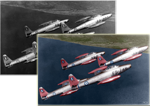


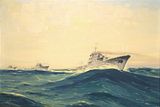
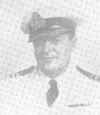 Three days before Greece falls to the Germans, Vasilissa Olga escapes to Alexandria, where she is assigned pennant number H 86 by the British. New captain is Georgios Blessas (photo).
Three days before Greece falls to the Germans, Vasilissa Olga escapes to Alexandria, where she is assigned pennant number H 86 by the British. New captain is Georgios Blessas (photo).
